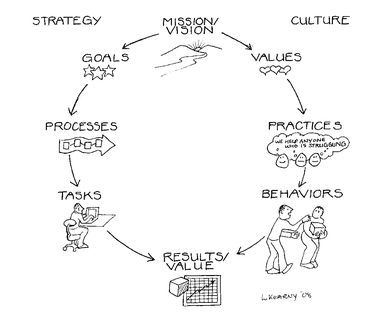PRACTICES: THE MISSING LINK
Most of this chapter has focused on making processes visible so we can streamline and improve them. In the workplace, we have increased our ability to improve business processes. Six Sigma and “lean manufacturing” have afforded many methods and tools to aid us. However, even as the processes improved how work is accomplished, in many cases performance has not improved. In some situations, performance has actually decreased. What is the problem?
Ten years ago, one of us started shopping at his local grocery store. The prices were higher, but the store was convenient. Over the years, the consultant noted that he always went to the same people to check out and avoided others. He stood in line, put his items on the magic belt, the checker ran the items through the magic eye, the total rang up, he gave the checker a credit card or cash, someone asked “paper or plastic” and put the items in paper bags, and he left the store. The process was the same. The difference was in what the checker did. The checkers our consultant avoided did not seem to recognize who he was. Those checkers took his money and rarely thanked him for his business. The checker he would wait in line for asked the consultant how he was doing, said it was nice seeing him again, and thanked him for shopping there. The process was the same. The difference was in what the checker did, her practices.
When an organization’s cultural practices, the way we do things around here, are aligned and in harmony with its processes, then we see an increase in the performance coefficient.
In 1994 Don Tosti and Stephanie Jackson suggested an organizational alignment model that would increase our understanding of the alignment between strategic process factors and cultural practice factors (see Figure 3.8).
FIGURE 3.8. Organizational Alignment Model.

This alignment model can be used to troubleshoot an organization that isn’t really producing desired results, even though the strategic factors seem to be in place. Alignment is critical to any system, any organization, any automobile, or the human body. If the Worker, Work, Workplace, and the World are not aligned, we will not produce the desired results. Thus, “the primary management function, then, is to ensure alignment across levels” (Tosti, 2003, p. 1).
A manager’s job is to support the organization’s mission by identifying the goals, processes, and tasks to support and produce the results. In addition, the manager identifies the values, practices, and behaviors necessary to support and achieve those results. To increase performance and solve performance issues, it is important to consider the Worker, Work, and Workplace. Results depend on both the processes—what we do, and the practices—how we do the job. “Even with well-designed processes, the behavioral practices of groups and individuals can make the difference between merely adequate results and outstanding results. In the worst case, poor practices can destroy good processes” (Tosti, 2003, p. 2). Here is the full text:
“How do you determine the desired strategic processes and cultural practices?
“First, identify the desired results. Then work backwards to determine the tasks, processes, and goals to support and achieve them. Do the same for the other side of the Organizational Alignment model, working backward to determine the behaviors, practices, and values that needed to support and achieve the results.”
© 2003 Donald A. Tosti and Vanguard Consulting, Inc. Used with permission.
Following this logic, we can use a reversed alignment model to start with the results we want and plan how to get them by aligning upward. A reverse model is shown in Figure 3.9.
FIGURE 3.9. Reversed Organization Alignment Model.

..................Content has been hidden....................
You can't read the all page of ebook, please click here login for view all page.
